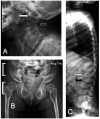| ~40 genes |
AD spinocerebellar ataxia (SCA) (See Hereditary Ataxia Overview.)
| AD | Progressive ataxia | Less skeletal disease, typically later onset than type III GM1 gangliosidosis (but early onset may be seen in some AD SCAs) 1 |
|
AR
|
Spinal & bulbar muscular atrophy
| XL | Neurogenic weakness, tremor, cramps & fasciculations, slow progression | Tongue atrophy, facial weakness, androgen insensitivity, gynecomastia, glucose intolerance |
|
ATP7B
|
Wilson disease
| AR | Tremor, poor motor coordination & weakness, dysphagia, dysarthria, dystonia | Liver cirrhosis, liver failure, hypoparathyroidism, ↑ urinary copper, ↓ serum ceruloplasmin |
C9orf72
FUS
SOD1
TARDBP
(>30 genes) 2 |
Amyotrophic lateral sclerosis (ALS)
| AD
AR
XL | Progressive neurogenic atrophy, cramps & fasciculations, spasticity | Neurogenic atrophy is often asymmetric; bulbar onset (in some persons), absence of cerebellar deficits |
CHCHD10
TFG
VAPB
|
Late onset SMA (See CHCHD10-Related Disorders.) & SMA-like disorder (OMIM 604484, 182980)
| AD | Neurogenic atrophy | Large kindreds, no cerebellar deficits, ↑ CPK in some affected persons |
CLN6
CTSF
DNAJC5
|
Adult-onset neuronal ceroid-lipofuscinosis (OMIM 204300, 615362, 162350)
| AR
AD | Ataxia | Seizures, myoclonus, early intellectual deterioration |
DNAJC6
FBXO7
PARK7
PINK1
PRKN
SYNJ1
VPS13C
|
Early-onset Parkinson disease
|
AR
| Dystonia, tremor, rigidity | May involve cognitive dysfunction |
|
FXN
|
Friedreich ataxia
| AR | Ataxia, dysarthria, neurogenic weakness & long tract findings, slow progression, scoliosis | Cardiomyopathy, EKG conduction defects, diabetes, pes cavus, slow sensory nerve conduction velocity, optic atrophy, hearing loss, neurogenic bladder |
|
HEXA
|
Tay-Sachs disease (See HEXA disorders.)
| AR | Progressive motor weakness beginning in lower extremities | Dysarthria w/pressured speech, characteristic pattern of anti-gravity muscle weakness/atrophy, absence of skeletal involvement |
|
HEXB
|
Sandhoff disease 3
| AR | Progressive motor weakness beginning in lower extremities | Sensory neuropathy |
|
HTT
|
Juvenile Huntington disease
| AD | Ataxia, rigidity | Depression, personality change, seizures |
|
SMN1
|
Later-onset spinal muscular atrophy (SMA types III & IV)
| AR | Tremor, fasciculations, atrophy, cramps, proximal muscle involvement, scoliosis | Tongue fasciculations, progressive ↓ in pulmonary function, absence of ataxia |




